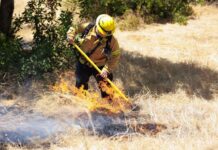Northern storm leaves behind a sole survivor
Homer Buck suddenly pointed upward.
”
Look!
”
he yelled and we all looked to see a dark whirling cloud rapidly
descending upon our ship.
It was a huge flock of finches that looked like mottled
parakeets. There were thousands of them and they sought shelter in
between the hatches, on the tops of cabins and wherever they could
find space.
Northern storm leaves behind a sole survivor
Homer Buck suddenly pointed upward. “Look!” he yelled and we all looked to see a dark whirling cloud rapidly descending upon our ship.
It was a huge flock of finches that looked like mottled parakeets. There were thousands of them and they sought shelter in between the hatches, on the tops of cabins and wherever they could find space.
“We’re in for some weather,” said Al Koenig, the first assistant engineer.
I was 19 that May of 1953 and making my first trip up above, to Lake Superior, aboard the John P. Reiss, en route to Ashland, Wisconsin with a load of coal. It was a beautiful day with the sky as blue as the lake itself.
I had just turned out the light that night in the cabin I shared with Fred Wilson and Harry Dial, the other deckhands, when the second mate stuck his head in. “Turn out. We’ve had storm warnings and the skipper wants to make sure the hatches are secure.”
I roused Wilson and Dial with the instructions, and stepped out on deck. The weather suddenly exploded – there is no other word for it – and we were thrust into a world of howling wind and driving rain.
We donned storm gear and made our way along the 30 hatches above the hold. The tarpaulins covering the hatches were secured by long strips of wood called battens, and we had to tighten their vises, called dogs, with short lengths of pipe.
I looked up for a moment and saw in the distance the lighted outline of a ship climbing a tremendous wave, balancing atop the crest for a moment, then diving downward. It struck me that our ship must look the same way to its crew.
After 90 minutes with all the hatches secure, we stumbled into the galley, exhausted and numb. A knot of shipmates huddled around a short-wave radio. Bill Gridley murmured, “The Henry J. Steinbrenner’s sinking. They don’t know if there are any survivors.”
Everyone was subdued the next day as we washed the thousands of bodies of the finches from the deck and scuppers with high-power hoses. They had been battered to death by the wind or drowned or frozen.
All except one. It had somehow got into the galley and sat nearly immobile in a corner. Dial lined a box with cloth and placed the bird in it. Every few minutes, it would peep once and seem to listen.
The Coast Guard reports came in all next day. The Steinbrenner’s hatches blew off as the gale reached 75 miles per hour, water poured into its hold and it quickly sank in 100 fathoms off Isle Royale. Seventeen of her crew of 31 died; some drowned but eight who made it to the lifeboats froze to death before help arrived.
Several other Steinbrenner ships passed us over the next two days, each with its flag at half-mast.
The third morning after the disaster the surviving finch suddenly took wing as someone entered the galley. It flew out, straight up and, as we lined the rail to watch, circled the ship three times before it flew shoreward and finally disappeared from view.
Of all its world, it alone had survived.
By Herman Wrede, Special to the Pinnacle







